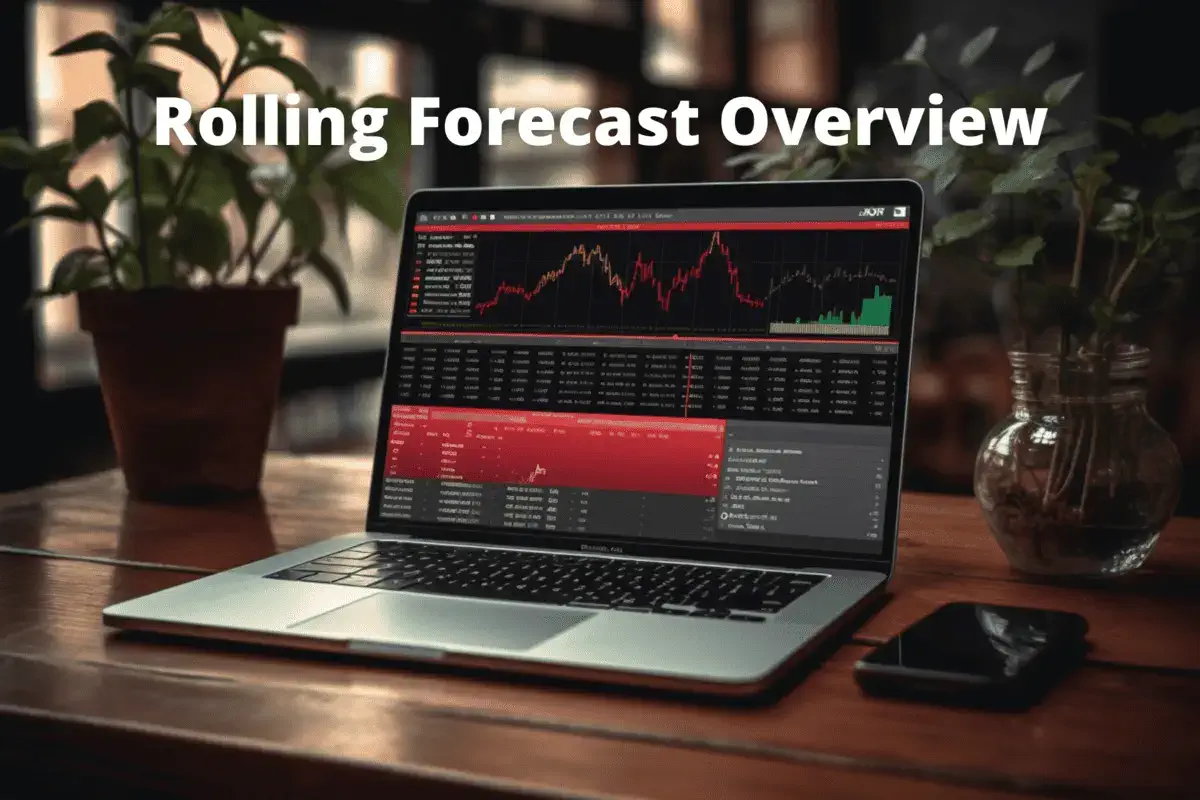Rolling Forecast: Definition, Benefits, Implementation
In finance, you’ll always want to ensure you have funds for your business. To stay ahead means predicting how much money your business will make in the future.
A “rolling forecast” emerges as a way to calculate this, offering a structured yet flexible approach to financial planning, unlike traditional forecasting, which remains static.
We’ll explain more details on rolling forecasts and how it may be a game changer for your business.
Table of Contents
What is a Rolling Forecast?
A rolling forecast is a financial tool that allows corporations to project future outcomes based on historical data. You’re predicting your company’s financial standing in the coming year or quarter.
These future projections are not set in stone but are consistently updated, typically on a monthly or quarterly basis. Thus, you’re not looking at an unchanging 12-month outlook but an evolving landscape that rolls forward with each new cycle.
Why is Rolling Forecast Important?
Think of the rolling forecast as your ‘business GPS.’ Like your car’s GPS, a rolling forecast helps you make necessary adjustments to your route in real time. You’re not just static, waiting for the end of the year to realize you’ve drifted off course; instead, you continually update and revise based on current business conditions.
It allows organizations to stay agile and adaptable in a changing market. But that’s not all – there’s more! A significant point about rolling forecasts is how they can seamlessly link strategy with operations.
Far too often, businesses make grand strategic plans but need to improve when it comes to effective execution at the operational level. Well-designed rolling forecasts bridge this gap and provide a roadmap that aligns strategic objectives with day-to-day operations. Rolling forecasts also shine in their ability to aid risk management.
Related Content: Best Business Budgeting Software
Benefits of Rolling Forecast
Improved Accuracy
One standout advantage of the rolling forecast is its ability to enhance the accuracy of predictions. A rolling forecast keeps updating as new data comes in.
What this means is that instead of basing decisions on information that could be outdated or irrelevant, you’re using the most recent data. This continual update makes forecasts more precise because they reflect current trends and variables.
Flexibility in Planning
Another advantage of a rolling forecast is the flexibility it extends in planning. Unlike traditional budgeting or forecasting methods, where estimates are often defined rigidly for a set fiscal year, rolling forecasts allow businesses to look beyond that arbitrary timeline.
This adaptability matters because, let’s face it, the operational dynamics of businesses today are substantially variable and continuously evolving. They don’t always fit neatly into a 12-month forecast period.
There’s room to consider variables that have not yet factored into annual budgets. – things like market fluctuations, economic trends, or unforeseen operational challenges. With an opportunity to regularly reforecast based on these changing elements, update plans as needed—thereby yielding more effective strategies and agile business models.
Enhanced Decision Making
When you have real-time information, decision-making becomes less about guesswork and more about strategic planning. For instance, if sales are trending higher than projected, you can move up production earlier than planned or make critical investment decisions proactively.
A rolling forecast gives organizations insights into potential future scenarios and allows them to make strategic decisions with confidence. It brings foresightedness into your financial planning process and empowers leaders with valuable insights for more effective decision-making.
Moreover, it uncovers new opportunities and risks, enabling businesses to react appropriately. Business leaders can nimbly navigate through economic uncertainty and capitalize on emerging trends. Access to data-driven projections means executives can make informed decisions rather than relying on gut feelings or an outdated static budget.
Implementing Rolling Forecast
Steps to Start Rolling Forecast
First and foremost, determine your forecasting horizon. Decide how far into the future you want to forecast. To make this decision, take a little time to consider your business’s unique needs and goals. For many companies, indicating 12-18 months is the best recommendation.
Next, define your key drivers. Ask yourself what factors most significantly impact your revenue and expenses. These could be anything from product sales volume to price fluctuations in raw materials or operational costs such as salaries or rent. Once you’ve identified these crucial elements, they become the backbone of your rolling forecast.
The third step is setting up a model for your forecast. It can be as simple as a spreadsheet. Still, there are also many specialized software solutions available that can automate parts of the process and handle large volumes of data more efficiently.
Remember to track actual results against the forecasted numbers regularly – typically monthly or quarterly. Using these metrics helps you identify where predictions differ from actual results, and then you can adjust future forecasts.
Like any new process, implementing rolling forecasting will present its own unique set of challenges.
Common Challenges
Implementing a rolling forecast has its share of challenges. The forecasting process can be daunting, especially for organizations that only use traditional methods for years.
One commonly faced challenge is the resistance to change. People, especially those who have grown accustomed to static forecasting, might find it challenging to adapt to the dynamic nature of rolling forecasts often because they are comfortable with the predictability and familiarity of old systems.
Another significant hurdle relates to data management. Rolling forecasts require regular updates and, therefore, constant interaction with data. It’s problematic if an organization needs more efficient data management systems or if there is a shortage of personnel experienced in dealing with such intensive data manipulation.
There’s the challenge of time consumption. Although rolling forecasts are intended to make planning and decision-making more streamlined over time, they initially demand a substantial amount of time investment due to their frequent updating nature.
Some members within an organization may view it as an administrative burden rather than a valuable business tool.
With proper understanding and planning, an open mindset towards change, and efficient use of technology and resources — organizations can overcome these obstacles effectively.
Rolling vs. Static Forecasting
Regarding forecasting, there are generally two camps: those who value the traditional static approach and those who favor the more dynamic rolling type.
You see, when it comes to static forecasting, it’s all about sticking to a specific plan for an entire year or even longer, irrespective of what might unfold in the business environment.
This model has its merits. It provides consistency and allows long-term planning, benefiting sectors where trends change slowly.
However, on the flip side, we have rolling forecasts. These are financial models that extend into the future just as static forecasts do but take into account up-to-date and flexibility for updating assumptions based upon changing market conditions or strategic decisions by management.
Which One to Choose?
When selecting between rolling and static forecasting, there is more than a one-size-fits-all answer. The ideal choice depends on various factors, such as the nature of your business, industry volatility, and your organization’s ability to adapt to change.
Rolling forecasts are excellent for companies operating in dynamic environments where change is the only constant. These businesses need more than a static glimpse into the future; they require a flexible forecasting model that evolves with changing circumstances.
Rolling forecasts allow you to keep your finger on the pulse of business performance and make adjustments as required. Ideally, smaller businesses may prefer to utilize rolling forecasting as things may frequently change from starting or adjusting strategies to growing bigger.
On the other hand, if you’re in an industry that enjoys relative stability or if your organization is still growing and becoming acquainted with its market dynamics, then static forecasting might be a better fit. Static forecasts provide simplicity and ease of understanding for those who still need to devote resources toward frequent forecasting exercises.
What matters most is selecting a model that best aids in strategic decision-making for your company’s sustained growth and success.
Best Practices in Rolling Forecasting
Regular Review
One of the most salient aspects of making your rolling forecasts work for you is the practice of regular review. Think about it: what good is a forecast if it isn’t updated to reflect the recent changes in your business environment or strategy?
Regular review should ideally be on a monthly or quarterly basis. This frequent viewing ensures that your projections align with actual performance and highlights any variances swiftly so they can be rectified or capitalized upon.
Also, it’s an opportunity to adjust your forecast based on new business developments, shifts in market dynamics, or changes in overall strategy.
Make sure to undertake these reviews in collaboration; involve other key stakeholders from different business departments, too. Their first-hand insights into particular operations can provide invaluable input into creating a more accurate forecast and promoting interdepartmental cooperation.
Utilizing Technology
Embracing technology is an essential aspect when dealing with rolling forecasts. There are tools and software designed to streamline the process, making it more efficient and manageable.
For instance, cloud-based forecasting solutions can automate data collection and calculation processes, saving you time on manual labor.
These platforms typically come with features for scenario analysis and predictive modeling, which help anticipate future performance based on historical data—moreover, AI-driven forecasting tools have been added or developed in the finance market.
These intelligent systems use machine learning algorithms to recognize patterns and trends that would otherwise be impossible for humans to identify manually. They continually learn from the data they process, increasing their prediction accuracy.
By incorporating such advanced technologies into your rolling forecast processes, you’re not just keeping pace with contemporary corporate financial strategies; you’re pulling ahead.
Closing Thoughts
With increased accuracy in forecasting, companies can confidently focus their operations toward a profitable direction. There may be hurdles in its adoption. However, these are manageable with adequate preparation and commitment.
Deciding whether to implement a rolling forecast will vary from business to business. It depends on the specific needs and capabilities of your organization, as you may not require a rolling forecast and stick to static.

